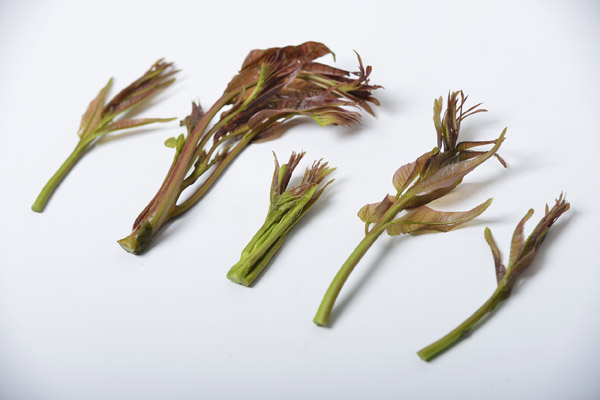 |
|
Toon shoots are among the popular spring vegetables. [Photo provided to China Daily] |
During the Qingming period, when families remember their ancestors and tidy the family graves, bunches of mugwort are hung up on doorways to repel pests and pestilence. The weed is also pounded and its juice extracted.
The dark liquid is mixed into glutinous rice flour for the seasonal qingtuanzi, or green balls. This seasonal sweet snack is especially popular in places south of the Yangtze, such as Shanghai, Suzhou and Yangzhou.
In the warmer climates where spring comes earlier, jasmine buds, telosma - the flowers of the Chinese cowslip vine - and tender cassia blossoms are also popular. These slightly sweet flowers are often mixed into an omelette or made into a delicately scented egg drop soup.
In spring, wherever an elm tree grows, people living nearby will look forward to the tender seed pods, the elm "coins". They are harvested and cooked for a special pancake.
The Chinese find spring greens fascinating after the long hard winter, and even the freshly sprouted shoots of willow are foraged. Are they edible? Yes. Do they taste good? That's debatable.
But these are the rituals of spring for many Chinese who have gone through the hard times, or are not so far removed from their agrarian roots. Nature helped with her gifts in times when food was scarce, and enjoying them is a grateful memorial to such times.
My favorite spring vegetable has to be the toon shoots from our two trees. The Chinese toon is pretty widespread, found the length and breadth of China. It is a tall, lanky tree with dull green leaves that grow undisturbed at the bottom of most gardens.
Perhaps if you brush against it you may get a hint of its special pungency.
It sheds its leaves in winter and, when the sap begins to run in the spring, it puts out clusters of deep maroon shoots. This is what we've been waiting for.
These shoots are delicious when lightly blanched and chopped and generously scattered over soft tofu, dressed with a light soy sauce and sesame dressing.
Or they can be dredged through a light tempura batter, deep-fried and served as beer food. Another favorite way to serve it is to chop it up and cook it in an omelette.
Why the fascination with toon?
It has a very distinctive fragrance, which some describe as a mixed bouquet of allium flavors such as leeks, garlic or chives ... but not quite. For those who like the taste, it can be addictive and having a platter of xiangchun on the table is a sure sign that spring has finally arrived.
Fortunately, the xiangchun, or toon tree, is very fast-growing, despite losing most of its shoots every year, and it is prolific in most cities in the north.
There are many more spring plants that are popular with certain ethnicities in China but are considered weeds in other communities. In the Inner Mongolia autonomous region, for example, the tender shoots of nettles are harvested as a vegetable.
These are blanched to get rid of the sting, then dressed in garlic juice. Dandelion greens, known as kucai, or bitter vegetables, are eaten in a similar way.
Weeds, herbs, flowers, shoots ... did someone say that the Chinese will eat anything? Well, not quite. They certainly eat only the freshest.